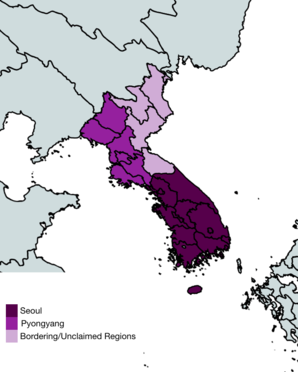Joseon
Korea is the current successor to previous Korean nations of the peninsula and Joseon. It was founded by Sulakeken in efforts to unify the Korean towns of the peninsula and for the independence of the nations from other nations.Template:Nation template
Territory and Administration
History
Old Seoul 前서울
In efforts to begin the history of the Far East, bahk settled in the southern Korean peninsula, specifically Seoul, and created the town of Old Seoul. With a neighboring town in Mokpo (located at the southwestern tip of the peninsula), the leader, ewanthehero, formed an alliance with Old Seoul.
Baekje 백제 (百濟)
Later on, bahk created the kingdom of Baekje and colonised the northern areas of the Korean peninsula and the southwestern areas of Honshu, Japan. Baekje was formed during The New Era. Its existence played a significant role into cultivating Korean culture, governmental system and architecture to Japan. Baekje later came to a fall when bahk had relocated to Japan in efforts to colonize the island of Honshu in attempts of preventing the spread of Panama and promoting the true values of the Far East cultures throughout Japan. The home territories in the Korean peninsula had lasted until the late 1st Intermediate Period of Japan. Many of Baekje's territories have been reclaimed by different colonies in order to claim valuables of the kingdom's remnants.
Jeon-Joseon 전조선 (前朝鮮)
Joseon was released from Jing as a subject in 198 A.C., granting Korea a land to reunite. This prompted a remodelling project to make Seoul traditional. However, when the province of Ma under Synargle rebelled and formed the nation of Ma. Kabospelar collapsed Joseon in retaliation for Syn rebelling on December 12th (201 A.C.), putting the entire region at risk of becoming outpost rushed.
The Great Divide Period 대분세시대 (大分稅時代)
The Soviet Union became increasingly greedy in making gains over their enemies, and made an outpost after a new Seoul was established. After holding Korea for ransom, GUI66 was banned as Jing settled to have his outpost removed by force and have someone to make an example out of. Oliveer's outpost was allowed to stay until it was time for it to expand.
External Affairs
Attention by toxic players was relatively overlooked as they were distracted with Jing China and Tibet. To the north, 1 chunk cities were made by players over-promising their ambitions to make a communist Korean nation (DPRK) and becoming inactive soon afterwards. Pyongyang was ruled by an inactive player which made unity physically impossible until the town could collapse, which it eventually did.
The Korean peninsula was in chaos and it was a time where it was anybody's chance to gain control over the lands. This state of turmoil lead to the territorial conflicts between neighboring and internal powers. The Joseon nation had fell and the peninsula soon became controlled by different nations.
The Vassal States Period 제후시대 (諸侯時代)
Four major colonies were formed in the peninsula: Seoul (south), Neo-Pyeongyang (north-west), Tongkpu (north) and Hyesan (north-east). Seoul was ruled by Sulakeken and was a vassal state of Jing, Neo-Pyeongyang was ruled by Steamboy101 and was a vassal state of Lantau, Tongkpu was ruled by lucled and was an independent town, and Hyesan was ruled by bahk and was in alliance and joint with Seoul as another vassal state of Jing. There was another state in the center of the peninsula but was disbanded due to pressures from neighboring states. There were no wars and violence that occurred between these states, however, governmental and territorial conflicts created disputes and debate about who was to control over the whole peninsula. There was a time where each leader had discussed to create a joint Korean nation, specifically a nation divided into provinces. This organization was named, Panmunjeom (판문점), however, the idea of a provincial nation was later forgotten due to the inactivity of Hyesan and Tongkpu (including their disbandments).
South and North Korea 남북한 (南北韓)
Neo-Pyeongyang and Seoul became the succeeding states over the peninsula. Neo-Pyeongyang grew larger into the south-western territories while Seoul grew throughout the southern peninsula. Both states were at uneasy conflicts due to their differing ideologies, where Steamboy101 had an ideal unified Korean nation divided into two provincial halves from the 38th parallel while Sulakeken wanted to unify the whole peninsula under Seoul as a Joseon monarchy. This resulted in a ceasefire between the states and resulted in a period where both coexisted under their respectful nations.
Later on, both nations grew to respect each other's ideals and negotiations and discussions were made. Ultimately, both towns aimed for a unified Korea. Hence, the leaders decided to form an alliance and worked together to unify the peninsula, with Neo-Pyeongyang claiming the north and Seoul claiming the south.
The Japanese Imperial Colonization 일본제국식민지화 (日本帝國植民地化)
The Japanese Imperial government grew larger and was soon close to unification of the Japanese islands. They have spread their colonies beyond their lands and conquered Asian countries throughout time. Few towns in and around the Korean peninsula have joined Japan and became colonies of the Japanese in Korea. In great concerns, Sulakeken built The Korean Wall around the whole peninsula and made territorial claims of the walls in efforts to prevent any internal towns or external towns from expanding. The largest colony of the Japanese was "Pyongyang", located in the north-east of the peninsula, which was ruled by
